Medicine & Health
200 Tons/Year Ginseng Extract Production Line Construction Project of Tonghua City
1 Introduction to the Project
1.1 Project background
1.1.1 Product introduction
Ginseng has been known as the “King of All Herbs” since ancient times, and is also praised by the Oriental Medical Community as the best product for “nourishing yin and tonifying body fluid, and strengthening and consolidating body resistance”. As the foremost of the Three Treasures in Northeast China, Ginseng is renowned both domestically and internationally.
Ginseng extract is refined from the roots, stems and leaves of ginseng plant in the Araliaceae family. It is rich in eighteen types of ginseng monomeric saponins, and is soluble in water at 80°C and easily soluble in ethanol. It is mainly applicable to symptoms such as coronary heart disease, angina pectoris, bradycardia, tachycardia, ventricular premature beat, blood pressure disorder, neurasthenia, menopausal syndrome, excessive fatigue, as well as post-illness, postpartum, and postoperative physical weakness, etc.; Long-term use of it can prolong life, enhance physical strength, and treat immunocompromise and other symptoms caused by radiation therapy and chemotherapy in cancer patients; it has anti-cold and heat stress effect. Meanwhile, it has the effects of enhancing the vitality of human surface cells and inhibiting aging, etc.
The project is located in the Ji’an Qinghe Aoyang Ginseng High-tech Industrial Park. Relying on the rich genuine Changbai Mountain ginseng resources in Ji’an and its surrounding counties and cities, it produces various ginseng extracts (including ginseng root extracts, ginseng stem and leaf extracts, and ginseng fruit extracts, etc.) to improve the deep-processing level of ginseng.
1.1.2 Market prospect
(1) Development status of the ginseng industry
The upstream of the ginseng industrial chain is mainly ginseng planting industry, with raw materials including seedlings, land, fertilizers, agricultural machinery, and facilities, etc; The midstream consists of ginseng processing enterprises, mainly including ginseng initial processing enterprises and ginseng deep-processing enterprises; The downstream mainly includes two categories: traditional Chinese medicine (TCM) enterprises and consumers of ginseng products.
Table 1 Ginseng Industrial Chain Diagram
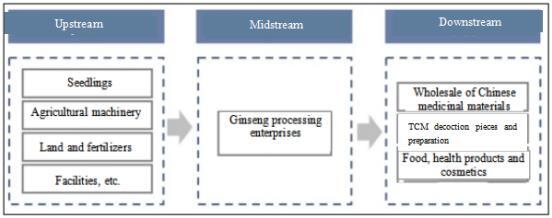
Ginseng is not only one of the “Three Treasures in Northeast China”, but also regarded as the “King of All Herbs”. In recent years, with the improvement of people’s living standards, the value of ginseng has been increasingly valued, and its market size has gradually grown. In 2023, the output and demand of ginseng in China reached 91,934 tons and 95,675 tons, respectively, with a year-on-year growth of 4.2% and 6.2%, respectively. In 2023, the ginseng market size in China reached 35 billion yuan, and maintains a high compound annual growth rate. In the future, with the improvement of national living standards and the enhancement of health awareness, the demand for traditional tonics such as ginseng will continue to increase.
Ginseng is a unique and advantageous resource in Jilin Province, and the ginseng industry has the most advantageous characteristics in Jilin Province. As the largest ginseng production base and trading hub in China, the ginseng out in Jilin Province accounts for about 60% nationwide and 40% worldwide. The raw ginseng traded through the Changbai Mountain ginseng market accounts for about 85% of the national trading volume every year, and plays a pivotal role in the ginseng industry in China and even the world. In recent years, Jilin Province has improved the level of deep processing, enriched product categories, promoted industrial optimization and upgrading, and striven to tap into the huge consumer market while ensuring the quality of ginseng.
In 2023, the planting area of garden ginseng in Jilin Province was 145,000 mu, with a fresh ginseng output of 34,000 tons; The area of under-forest ginseng was 1.165 million mu, with a fresh ginseng output of 781.8 tons. The comprehensive output value of ginseng industry in Jilin Province in 2023 was 70.85 billion yuan, with a year-on-year growth of 10.3%. Among them, the output value was 12.63 billion yuan for the primary industry, 24.48 billion yuan for the secondary industry, and 33.74 billion yuan for the tertiary industry, accounting for 17.8%, 34.6%, and 47.6%, respectively.
Table 2 Output and Growth Rate of Garden Ginseng and Fresh Ginseng in Jilin Province from 2016 to 2023
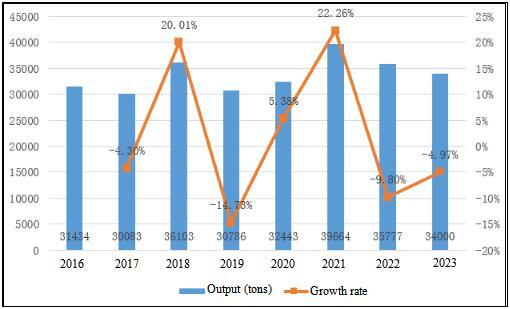
(2) Demand analysis
The traditional functions of ginseng, such as enhancing strength, prolonging life, and enhancing intelligence, etc., have been proven by modern medicine, deepening the people’s understanding of the credibility of traditional Chinese medicine and the correctness of classical arguments. Specifically, the active ingredients in ginseng include saponins, non-saponins, small molecule peptides and polypeptides, and polysaccharides, etc. Among them, ginsenosides have been studied the most due to their high content of Rgl and Rbl, strong activity, and wide range of effects. Rgl and Rbl are the main active ingredients of ginseng for promoting intelligence. The former can improve the entire memory process, while the latter has a facilitating effect on memory acquisition and memory reproduction. Ginsenosides are mainly used in the medicine industry, daily cosmetics, food and feed industry and so on. For example, in the food and feed industry, saponins have a life-prolonging effect and can be used as food additives.
With the continuous diversification of downstream demand for ginseng, the market demand for ginseng will show a trend of increase. It is expected that the domestic demand for ginseng will continue to grow rapidly in the next few years, and the demand for fresh ginseng in China may have reached 83,739.3 tons by 2028.
Table 3 Forecast of Fresh Ginseng Demand in China from 2024 to 2028
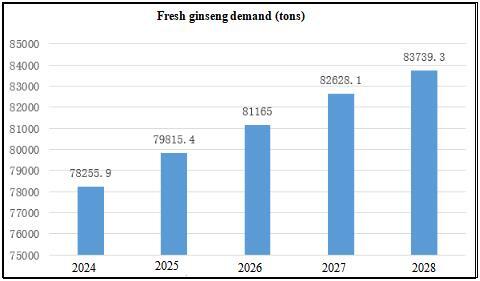
(3) Import and export volume of ginseng
According to data from China Customs, since 2017, the total import volume of ginseng related goods in China has fluctuated and increased, and the import amount has increased year by year. In 2022, the import volume of ginseng related goods in China reached 3,693.1 tons, with a year-on-year growth of 3,619.67 tons, or growth by 49 times; The import amount reached US$ 105.5039 million, with a year-on-year growth of US$ 73.49 million, a growth by 2 times; The growth in both the import volume and the import amount was driven by the consumption of “fresh or dried American ginseng”. In 2023, the ginseng import volume in China has increased to 5,753.17 tons, with a net import volume of 3,582.63 tons; The import amount increased synchronously with the trade volume to US$ 125.0342 million.
Table 4 Import Amount and Change Trend of Ginseng Related Goods in China from 2015 to 2023
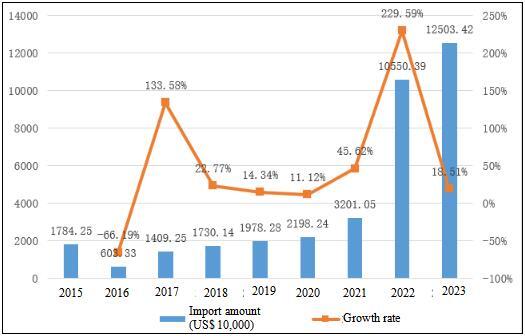
According to data from China Customs, from 2017 to 2022, the total export volume and total export amount of ginseng related goods in China showed a downward trend on the whole. In 2022, the total export volume of ginseng related goods in China reached 1,803.39 tons, with a year-on-year growth of 286.36 tons, and a growth rate of 18.87%; The total export value reached US$ 79.907 million, with a year-on-year growth of US$ 12.1672 million, and a growth rate of 17.96%. In 2023, the export volume of ginseng in China increased to 2,170.54 tons, and the export amount increased synchronously with the trade volume to US$ 90.8716 million.
Table 5 Export Amount and Change Trend of Ginseng Related Goods in China from 2015 to 2023
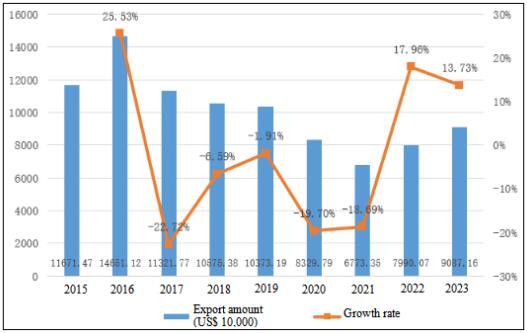
(4) Market analysis of the project
In 2023, the global market size of ginseng extracts was US$ 32.20 million, which was expected to grow at a compound annual growth rate of 6.15% from 2023 to 2028. The main reason for the significant growth of the global market size of ginseng extracts includes the increasing awareness among the consumers of the importance of a healthy lifestyle, as well as the rise in chronic disease cases and the rapid growth of the elderly population. Cardiovascular disease affects over 420 million people worldwide and is the leading cause of death. It is expected that the global population aged 65 and above will have reached around 1.5 billion by 2050, which will drive the growth of the global market size of ginseng extracts. In addition, the increasing awareness of the use of ginseng in nutritional supplements and medicines will further drive the growth of this market. The increasing demand for this product in various terminal application fields such as cosmetics and drugs, etc. has created huge market opportunities for the main participants in the ginseng extract market.
The project relies on the abundant ginseng planting resources in Ji’an area to build a ginseng extract production line, with a broad prospect for market development.
1.1.3 Technical analysis
The project adopts modern production technology and automated production lines, with mature production processes and technologies, and has the conditions for large-scale production.
(1) Dehydration treatment
Sun-dried ginseng is a ginseng variety produced through dehydration treatment. Sun-dried ginseng has undergone dehydration treatment by airing or drying in the sunshine, and has a service life of 3-5 years. It has many effects such as regulating blood pressure, calming the mind, and improving intelligence, etc.
(2) Steaming treatment
In order to extend the service life of sun-dried ginseng again, it was steamed again to obtain a cooked product of ginseng, namely red ginseng. Red ginseng not only has a service life of 10-15 years, but also has a much stronger ability to supplement deficiency than sun-dried ginseng, making it the most popular ginseng for people to buy.
(3) Extract nutrients
Various methods of processing ginseng can damage and impair the nutritional components such as ginsenosides, ginseng polysaccharides, trace elements, and proteins, etc. in ginseng to varying degrees. However, directly extracting the nutrients from ginseng can maximize and accelerate their absorption into the human body, which is one of the new methods for processing ginseng.
1.1.4 Advantageous conditions of project construction
(1) Policy advantages
In September 2022, six ministries and departments including the National Forestry and Grassland Administration, the Ministry of Agriculture and Rural Affairs, and the National Health Commission jointly issued the Opinions on Supporting the High-quality Development of Jilin Ginseng Industry, proposing to promote the inheritance and development of TCM characteristic health resources represented by Jilin ginseng, and to support the high-quality development of the ginseng industry throughout the entire chain.
In December 2021, Jilin Province released the 14th Five-year Plan for the Development of the Changbai Mountain Ginseng Industry in Jilin Province, which proposed to focus on promoting the extension of the deep processing chain of ginseng for medicinal, edible, and cosmetic purposes, etc., accelerate the research and development and achievement transformation of new products based on ginseng for pharmaceuticals, food, health products, biological products, cosmetics, and daily chemical products, and break through key technological bottlenecks.
In June 2022, Jilin Province issued the Implementation Opinions on Accelerating the High-quality Development of the Ginseng Industry in the Province, proposing that by 2025, the total output value of the ginseng industry should have reached 80 billion yuan, and key shortcomings in ginseng planting, processing, warehousing and logistics, etc. should have been basically filled, with a high-quality rate of fresh ginseng of over 85%; By 2030, the total output value of the ginseng industry should struggle to have exceeded 100 billion yuan and become an emerging pillar industry in agriculture throughout the province.
In order to support the better undertaking of industrial transfer in the Northeast China, promote the adjustment and optimization of industrial structure, and help achieve new breakthroughs in the comprehensive revitalization of Northeast China, in February 2023, the National Development and Reform Commission replied and agreed to establish a Southwest Jilin Industrial Transfer Demonstration Zone, covering three cities of Siping, Liaoyuan, and Tonghua. The demonstration zone will undertake seven major industries including medicine and health, equipment manufacturing, agricultural products and food processing, green energy carrier, modern chemical engineering, modern textiles, and cultural tourism. The project is located in the Southwest Jilin Industrial Transfer Demonstration Zone, and belongs to the medicine and health project among the seven major undertaking industries.
In August 2024, Tonghua City, Jilin Province issued and implemented the Regulations for High-quality Development of Ginseng Industry in Tonghua City, which clearly put forward specific requirements for quality improvement, genuineness protection, brand cultivation and protection, inheritance and development, supervision and management, etc. of ginseng. Through a series of institutional arrangements, it aimed to overcome the bottleneck issues that hinder the high-quality development of the ginseng industry, and provide strong regulatory support and legal guarantees for building a ginseng industry with a scale at one hundred billion level.
(2) Resource advantages
Ji’an is located at the southern foot of Changbai Mountain, with a good ecological environment. The ginseng produced in Ji’an is known for its excellent quality, beautiful shape, and high saponin content. It is the highest quality ginseng production area in Jilin Province. It has successfully been approved as a National Ginseng Modern Agriculture Industrial Park.
The current ginseng planting area in Ji’an is 166,300 mu (including 6,960 mu of garden ginseng, 9,345 mu of American ginseng, and 150,000 mu of under-forest ginseng); The total output of fresh ginseng is 4,583 tons, including 1,972 tons of garden ginseng, 2,571 tons of American ginseng, and 40 tons of under-forest ginseng.
(3) Industrial advantages
Ji’an has the largest wild ginseng trading market in the country - China · Qinghe (Aoyang) Wild Ginseng International Trading Center. This trading market is also a ginseng trading center in the country integrating ginseng culture exhibition, dissemination, and experience, with the largest construction scale and most complete service supporting nationwide. By now, more than 200 shops have settled and opened at the China · Qinghe (Aoyang) Wild Ginseng International Trading Center, with a trade amount of 3.5 billion yuan and a ginseng trade volume of 4,000 tons in 2021.
Leading enterprises such as Yisheng and Kangmei have cooperated with expert teams from Jilin University, Jilin Agricultural University, Institute of Special Animal and Plant Sciences of Chinese Academy of Agricultural Sciences and other units to make innovation. They have successively undertaken 26 national, provincial and municipal research and development projects, won 4 science and technology award projects above the provincial level, obtained 41 patents, made selected breeding of 6 new ginseng varieties, and formulated 7 national ginseng standards and 1 ginseng industry standard. Ji’an has now become the national ginseng production and processing technology innovation center and an important source of ginseng industry standards.
(4) Location advantages
Ji’an City is located in the southeast of Jilin Province, and the south of Tonghua City, at the southwest foot of Changbai Mountain, and adjacent to 5 districts and counties, with a total area of 3,341 square kilometers. The urban area of Ji’an City is 103 kilometers away from the highway of Tonghua City, 422 kilometers away from the highway of the provincial capital Changchun City, and 260 kilometers away from the highway of Dadonggang in Liaoning Province.
Ji’an City is located in the core area of the Yalu River International Economic Cooperation Belt, facing Manpo City, Jasong County, Chosan County, and Wiwon County of the Democratic People’s Republic of Korea across the river, with a border line of 203.5 kilometers. The domestic Ji’an Port is one of the three major ports for China’s trade with North Korea, and is also the only port city in Tonghua City. The China-North Korea International Train travels between the two countries every day, and it is an important gateway for Jilin Province to open up to the south.
There are two dedicated railways (international and domestic) in Ji’an City. The domestic Tonghua-Ji’an Railway runs through the north and south, providing direct access to Beijing, Changchun, Qingdao, Dalian and other places. The cross-border railway connects with Manpo City in North Korea and reaches the hinterland of the Korean Peninsula. The domestic railway is mainly the Tonghua-Ji’an Section of the Meihekou-Ji’an Line, with a length of 46 kilometers. It is a major transportation artery that crosses the southeast of Tonghua City, Tonghua County, and Ji’an City, and is also an important railway transportation line in Northeast China; The international route from Ji’an to Manpo in North Korea, with a length of 8 kilometers, is one of the important routes for exit from China to North Korea.
(5) Talent advantages
There are currently 19 ginseng research institutions in Jilin Province. There are 7 ginseng research institutions, including Academician Zhang Boli Workstation, Jilin Ginseng Research Institute, and Ji’an Ginseng Research Institute, etc. in Tonghua City, having achieved more than 40 provincial-level or above scientific research results. Seven new ginseng varieties, including “Xinkaihe No.1”, “Kangmei No.1”, and “Yisheng Chinese Ginseng No.1”, etc., have been examined and approved. The National Technical Standard Innovation Base (Ginseng Industry) has settled in Tonghua. Yisheng Pharmaceutical independently developed and produced Xinyue Capsules using ginseng as raw material, which is a national Class II new drug, and its ginseng hypoglycemic capsule is a national protected variety of traditional Chinese medicine. Its ginseng monomer Re is included in the National Spark Program. In addition, Tonghua Normal University established the Ginseng College in 2019, which has played a great role in cultivating ginseng professionals and strengthening the foundation of the ginseng industry.
1.2 Contents and scale of project construction
1.2.1 Product scale
The project produces 200 tons/year of various ginseng extracts (including ginseng root extract, ginseng stem and leaf extract, and ginseng fruit extract, etc.).
1.2.2 Contents of project construction
The project rents a standardized factory building in Qinghe Aoyang Ginseng High-tech Industrial Park, Jia’an Border Cooperation Zone, with a rented construction area of 6,600 square meters. The project will construct 4 ginseng extraction production lines (ginseng stem and leaf extraction production line, ginseng root extraction production line, ginseng monomer separation technology production line, and ginseng pesticide residue treatment production line), and construct related supporting infrastructure such as warehouses, utilities, and water purification treatment facilities, etc.
1.3 Total investment of the project and capital raising
1.3.1 Total investment of the project
The total investment of the project is 100 million yuan, including the construction investment of 80 million yuan and current funds of 20 million yuan.
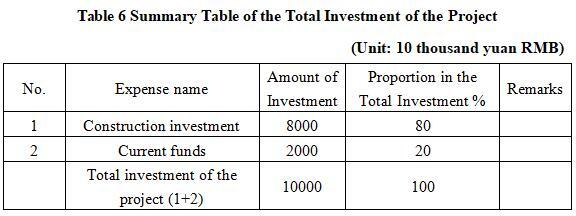
1.3.2 Capital raising
Raised by the enterprise itself.
1.4 Financial analysis and social evaluation
1.4.1 Main financial indexes
After the project reaches the production capacity, its annual sales income will be 200 million yuan, its profit will be 30 million yuan, its investment payback period will be 5.3 years (after the tax, including the construction period of 2 years), and its investment profit rate will be 30.0%.
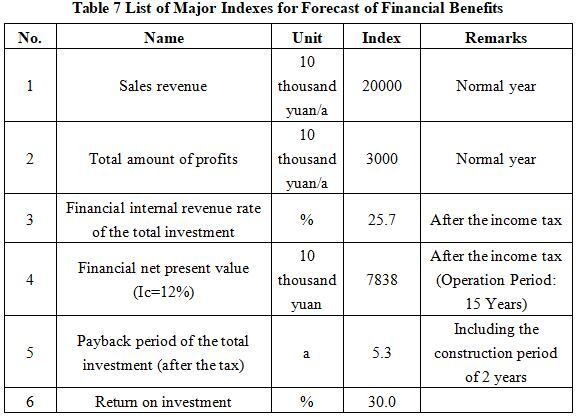
Note: “10 thousand yuan” in the table is in RMB
1.4.2 Social evaluation
The implementation of the project complies with national and provincial industrial policies, meets the requirements of Ji’an City’s industrial development plan, and is a priority choice for Ji’an City to vigorously develop the big health industry and achieve green transformation and development. After the project is completed and put into operation, it can fully leverage the advantages of Changbai Mountain ginseng resources in Ji’an and its surrounding counties and cities, improve the deep processing level of ginseng, extend the industrial chain, enhance the value chain, achieve the integrated development of rural primary, secondary and tertiary industries, and promote local economic development.
1.5 Cooperative way
Joint venture or cooperation, and other ways can be discussed in person.
1.6 What to be invested by the foreign party
Funds, equipment and technology.
1.7 Construction site of the project
Ji’an Qinghe Aoyang Ginseng High-tech Industrial Park.
1.8 Progress of the project
The project proposal has been prepared.
2 Introduction to the Partner
2.1Basic information
Name: Ji’an Municipal Bureau of Commerce
Address: No. 3001 Yajiang Road, Ji’an City
2.2 Overview
Located in the southeast of Jilin Province, Ji’an City covers an area of 3,341 square kilometers. It has jurisdiction over 1 provincial economic development zone, 11 towns and townships, 4 sub-districts, and 127 administrative villages, with a total registered residence population of 202,547, including 25 ethnic groups such as Han, Korean, Manchu and Hui, etc. It is a world cultural heritage site, a famous historical and cultural city in China, a national ecological demonstration area, an excellent tourist city in China, a national leisure agriculture and rural tourism demonstration county, a hometown of Chinese calligraphy, a national garden city, and one of the top ten frontier cities in China. Its GDP had a year-on-year growth of 5.6% in 2023.
Ji’an has four major business cards: firstly, it is a world heritage ancient capital. Ji’an has a long history and rich cultural heritage. The Goguryeo ethnic group, which existed for 705 years during the Han and Tang Dynasties, thrived and established its capital in Ji’an for 425 years, passing down 19 generations of kings and leaving behind a large number of cultural relics and historical sites. So far, more than 10,000 ancient sites and ancient tombs have been found in Ji’an. The Capital Cities and Tombs of the Ancient Goguryeo Kingdom have been included in the World Cultural Heritage List. Ji’an is the 30th world cultural heritage site in China. Secondly, it is the hometown of national ginseng. Ji’an has been one of the main production areas of ginseng, known as the “King of All Herbs” since the ancient times. Ginseng has a history of over 1,700 years of application and nearly 500 years of artificial cultivation. Ji’an ginseng is superior in quality, beautiful in shape and high in saponin content. It is known as the top grade of ginseng, with an output of about 4,000 tons/year of fresh ginseng. The “Xinkaihe” brand is the first well-known trademark of ginseng industry in China, and the “Ji’an Qinghe Wild Ginseng” is a national geographical indication protection product. The quality of its ginseng represents the highest level of Changbai Mountain ginseng, it is the world’s highest quality ginseng production area and the largest under-forest ginseng base. Thirdly, it is a major border town. Ji’an is located in the core area of the Yalu River International Economic Cooperation Belt, facing Manpo City, Jasong County, Chosan County, and Wiwon County of the Democratic People’s Republic of Korea across the river, with a border line of 203.5 kilometers, and complete domestic port authorities. The China-North Korea International Train travels between the two countries every day, and it is an important gateway for Jilin Province to open up to the south. Fourthly, it is a place of health preservation and happiness. Its forest coverage rate has reached 82.19%, and the proportion of days with excellent air quality has exceeded 90%. The favorable ecological environment and climate conditions have nurtured high-quality characteristic resources such as ginseng, mountain grapes, Schisandra chinensis, bee products, and edible fungi, etc. that are well-known throughout the country. It is the largest mountain grape production area in the country and an important raw material and production base for health food and health products.
2.3 Contact method
2.3.1 Contact method of cooperator
Contact unit: Ji’an Municipal Bureau of Commerce
Contact person: Zhu Qibiao
Tel: +86-435-6224912 +86-15944561889
E-mail: jajhzsk@163.com
2.3.2 Contact method of the city (prefecture) where the project is located
Contact unit: Tonghua Municipal Commerce Bureau
Contact person: Wang Liangchen
Tel: +86-435-3199017+86-18643036783
E-mail: thsswjtck@126.com


